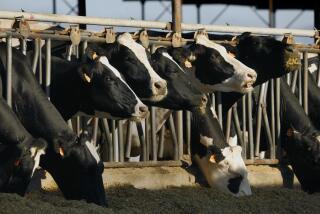âChicken Fluâ Is No Big Peril
Itâs been a frightening year for flu. First came the dire predictions out of Southeast Asia, where the explosive spread of H5N1 avian flu among chickens, along with the deaths of about 40 people, has spawned fears that the disease could mutate and cause a worldwide pandemic. Next, there was the flu vaccine shortage. But so far, the flu season has been milder than usual. Gradually, the flu panic has subsided.
Until last week. Last Monday, despite the absence of new data, Julie Gerberding, director of the Centers for Disease Control and Prevention, revived the specter of flu catastrophe and sent it flapping around the world again. In an address to the American Assn. for the Advancement of Science, she reportedly said, âEvery time thereâs a new [flu type], we get a new pandemicâ -- an erroneous remark her spokesperson, Tom Skinner, denies she made.
She now says there is no immediate threat of a flu pandemic in the United States, but sheâs still peddling this basic position: The circulation of lethal bird flu in Southeast Asia, and the diseaseâs ability to infect mammals, means that it will probably evolve to spread among people. When it does, we will have no immunity, because H5N1 is new to humans. And hundreds of millions may die.
In the past, new flu types from birds have indeed produced pandemics. In 1957-58, H2N2 flu spread around the world, causing 70,000 deaths in the U.S. In 1968-69, another variety, H3N2, killed about 36,000 in the U.S. -- comparable with a normal flu season. But these pandemics were mild compared with the only massively lethal flu pandemic in history, the 1918 flu, which killed between 20 million and 40 million people.
According to molecular biologist Jeffery Taubenberger, who has reassembled the genetic code for five of the eight genes of the 1918 flu, this disease did not come directly from birds. Still, the parallel between the 1918 flu (which killed, Gerberding reminds us, only 1% of the people it infected) and the present-day avian flu outbreak is constantly invoked. Infectious disease expert Michael Osterholm insists that because the planet is far more crowded and transportation more rapid than in 1918, H5N1 could cause the worst disease outbreak in history.
But this logic has more holes than a tennis racket. First, avian flu evolved to kill chickens, not people. It attacks people who drink infected chicken blood, wade in chicken feces or slaughter sick chickens for food. In other words, its human victims have typically been exposed to massive doses of chicken virus.
Second, H5N1 has evolved great virulence among chickens only because of the conditions under which the animals are kept -- crammed together in cages, packed into giant warehouses. H5N1 was originally a mild virus found in migrating ducks; if it killed its host immediately, it too would die. But when its next hostâs beak is just an inch away, the virus can evolve to kill quickly and still survive.
As evolutionary biologist Paul Ewald of the University of Louisville has pointed out, the same process âcookedâ the virulence of the 1918 flu, though instead of chickens in cages it was soldiers in World War Iâs trenches, hospitals and transports who fell victim to a virus that became increasingly deadly as it cycled among them.
It is faulty logic to expect that, in the absence of trench warfare or other human âdisease factories,â flu will evolve to be a pandemic terror. And no one has identified such conditions near the chicken farms of Southeast Asia. In other words, if avian flu ever does adapt enough to spread easily to humans, its lethality will have to drop. It may well cause another pandemic, as we indeed have no resistance to it, but it cannot be a pandemic as lethal as the 1918 flu.
In the meantime, although Gerberding has fixed our eyes on Asian chicken farms, a deadlier human nemesis is in production in a setting that could incubate worldwide disaster. A respiratory disease that Doctors Without Borders believes is pneumonic plague has killed about 60 people and may have infected 400 others in an open-pit diamond mine in northern Congo. This is the same plague that caused the Black Death, wiping out a third of Europe and Asia during the Middle Ages.
As CDC plague expert Ken Gage points out, this area isnât where plague is normally found. A traveler may have brought it to the crowded, squalid diamond mines, where it could have puttered along for a time, and then exploded. Doctors Without Borders estimates that 4,000 people have fled the region in fear of the disease. We donât know where they went, or how many of them are incubating the disease. We donât know where it will spread.
The logic is clear: Itâs human disease factories and not a virus mutating among chickens that should command our attention. We ought to be more worried about conditions such as the Congo mine, where sick people huddle with healthy people and deadly disease can evolve to terrifying effect, than about an avian flu threat that most likely will never come to pass.






